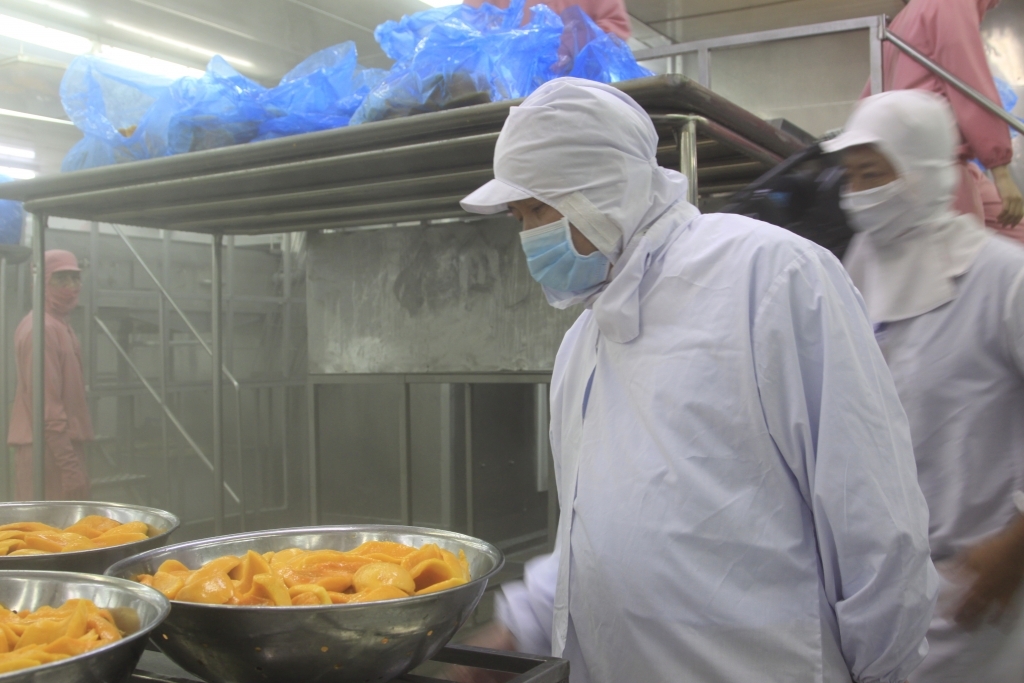 |
| The EU market increasingly attaches importance to technical requirements and food safety conditions for goods. Photo: Nguyen Thanh |
A special opportunity
Speaking at the conference “Prospects and solutions to promote exports to the EU in a new context” organized by the Vietnam International Arbitration Center on the morning of November 5, 2021, Ms. Nguyen Thao Hien, Deputy Director of the Department of The European – American Market (Ministry of Industry and Trade) said the EU market was recovering strongly.
However, it is worth mentioning that the supply of goods to the EU is disrupted. At present, it is the first time that importers of goods in the EU have thought about selling goods in moderation to reserve stock for the end of the year. “This opportunity is very difficult to repeat in history and Vietnamese exporters need to seize it,” said Ms. Hien.
In the context of the pandemic, the leader of the Europe-America Market Department emphasized the cross-border e-commerce factor. So far, 70% of Vietnam’s cross-border e-commerce had targeted the US market.
This is a large market, but there is no preferential tariff treatment like in the EU-Vietnam Free Trade Agreement (EVFTA). In the EVFTA, there is a chapter on e-commerce, whereby almost all commercial transactions of both sides are exempt from tax. Exporting goods to the EU via cross-border e-commerce is a new issue that enterprises need to pay attention to.
According to Ms. Hien, whether exporting via e-commerce or in the traditional way, Vietnamese enterprises always had to face and satisfy EU technical standards. Enterprises should actively monitor market developments and promptly grasp changes. During the pandemic, EU regulations, especially those regarding the movement of goods, changed frequently.
In addition to the usual regulations, the EU also has its own strict regulations for each item and product. For example, textiles, footwear and leather goods have their own set of regulations, agricultural products also have their own regulations.
“Enterprises must invest methodically and take advantage of advanced technology from EU investment in Vietnam to produce products manufactured in accordance with the technical standards of the EU,” Ms. Hien said.
Regarding this issue, Mr. Vu Chien Thang, Commercial Counselor of Vietnam in Spain, emphasized that the EU market in general and Spain in particular attach great importance to technical requirements and food safety conditions.
Recently, a number of Vietnamese products exported to the EU such as frog legs, pomelos, bitter gourds, and rambutan with shipments containing banned substances exceeding the EU market’s allowable limit, Spain issued a warning.
“In order to ensure safe conditions and technical requirements set by the EU, enterprises should pay attention to fully meet the requirements from farming, production, purchasing, preserving stages to processing and transportation, and absolutely should not violate current EU regulations. Only in this way, we can retain Spanish customers in particular and the EU in general,” said Mr. Vu Chien Thang.
Great concern
Some at the conference said that another matter of great concern when exporting to the EU market was commitments to show the social responsibility of exporting enterprises. For example, the enterprise’s commitment in ensuring the environment, on the issue of using the right age working group and working conditions for workers.
This is increasingly seen as a binding condition in signing sales contracts with EU partners. Even in the EVFTA, there are also separate regulations for labor and environmental protection issues for Vietnam’s exports to the EU.
Ms. Hien recommended that in the future, enterprises should focus on developing products in line with European consumption trends, which were smart and convenient products with full labels. Enterprises must focus on building a methodical business plan in the medium and long term.
The leader of the Europe-Americas Market Department said that, in the New Trade Development Strategy for the 2020-2030 period, the European Commission (EC) emphasized its determination to protect the interests of the EU and the health of the EU’s people by any means. The EU had applied many trade remedies in recent years.
During the 2010-2020 period, an average of 44 cases was filed by the EC annually.
Notably, the fact that products of China or some Southeast Asian countries with similar production background to Vietnam were included in the monitoring list or imposed anti-dumping and anti-self-defense tax, 1-2 years later, these goods of Vietnam would also be subject to investigation or tax.
“Therefore, enterprises and localities should pay attention to receiving investment from surrounding countries, to avoid the industry being affected because the EC discovers that other countries are taking advantage of Vietnam as a transit hub for export to the EU, evading trade remedies,” said Ms. Hien.
According to calculations from the General Department of Customs (Ministry of Finance), two-way trade between Vietnam and the EU after one year of implementing the EVFTA reached US$54.87 billion, up 12.1% compared to same period in the previous year. In which, export turnover reached US$38.48 billion, up 11.3% and import turnover reached US$16.39 billion, up 14.04%. In the first nine months of 2021, two-way trade between Vietnam and the EU still recorded positive growth, even compared to the pre-pandemic period, with a turnover of US$41.3 billion, an increase of 13.4% compared to the same period in 2020. In which, exports reached US$28.85 billion, up 11.7% and imports reached US$12.4 billion, up 17.6% over the same period in 2020. |
